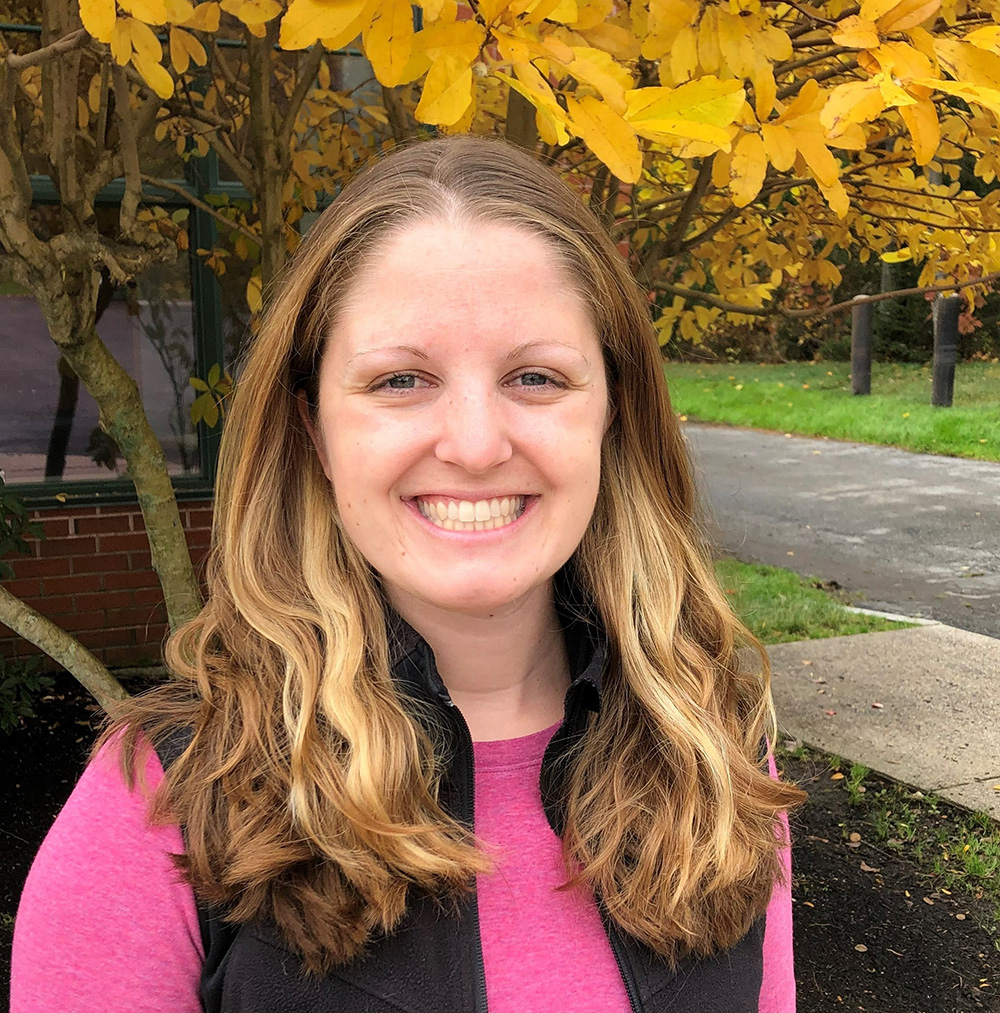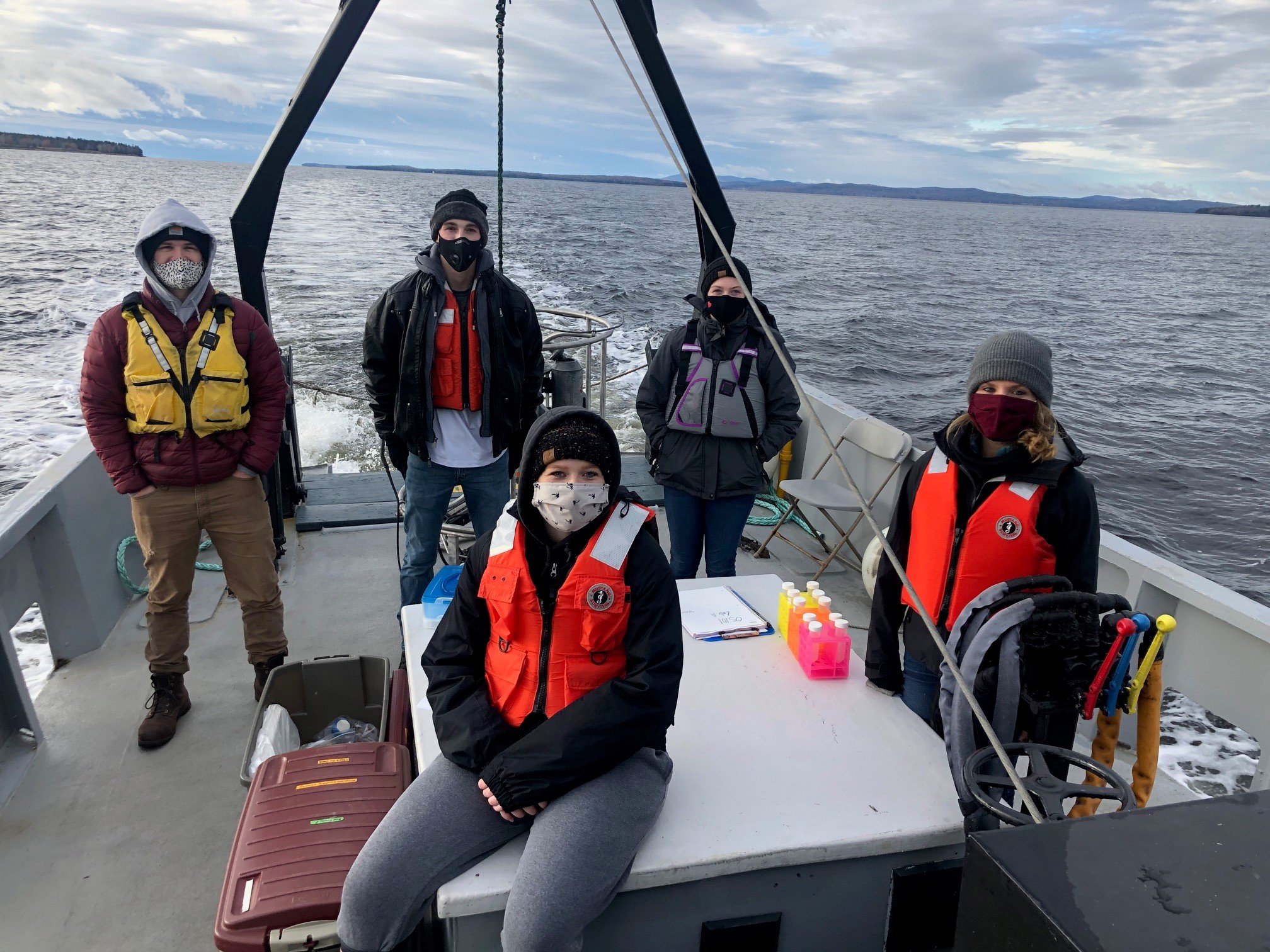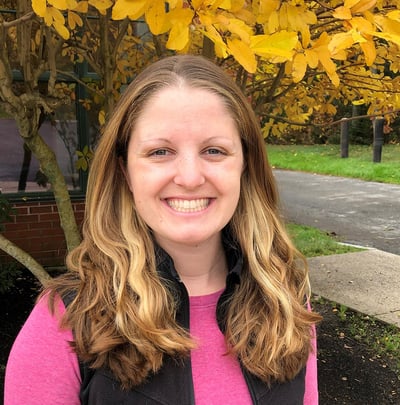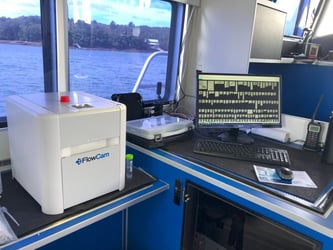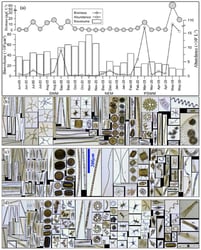Back by popular demand, the FlowCam Student Equipment Grant program has a new category specifically for undergraduate institutions. The recipients of this inaugural undergraduate grant were Drs. Kerry Whittaker, LeAnn Whitney, and Steven Baer of the Corning School of Ocean Studies at Maine Maritime Academy (MMA), a small college of about 950 students located in Castine, ME.
Through this grant MMA received a FlowCam 5000 for the fall semester of 2020, which Whittaker and Whitney incorporated into a first-year course that they co-teach called Introduction to Oceanography and Environmental Science (OS101 for short).
Pictured right: Drs. Kerry Whittaker (left) and LeAnn Whitney (right) show how they set up the FlowCam 5000 in their classroom. By connecting the FlowCam directly to a projector, Whitney and Whittaker were able to display live data acquisition and analysis on the FlowCam for the whole class. If they had been forced to teach remotely earlier in the semester due to Covid-19, Whittaker said she would have connected the FlowCam to her computer or to the internet to share the same screen with students remotely.
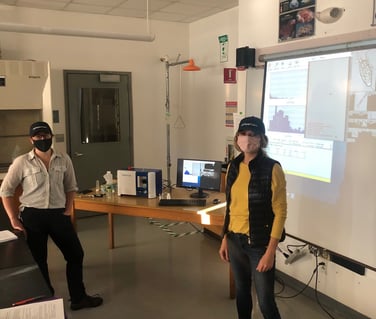
“OS101 is a highly hands-on and immersive introduction to marine science and oceanography for first year MMA students,” the team wrote in their grant application. “The course guides students through scientific research practices and introduces concepts of oceanographic data analysis and interpretation.”
Whittaker and Whitney developed two lessons involving the FlowCam that were designed to introduce the technology in phases. In the first lesson students learned what the FlowCam is, how and why it is used, and got their first glimpse of plankton images. Students then used these images to create scientific sketches of different types of plankton in their field samples. One of the learning goals of this first lesson was for students to think about the value of image analysis for ecological characterization and identification, which they were able to explore through digital FlowCam analysis and analog field sketching techniques.
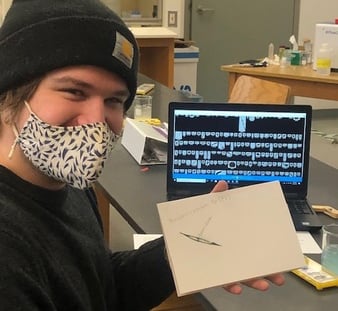 |
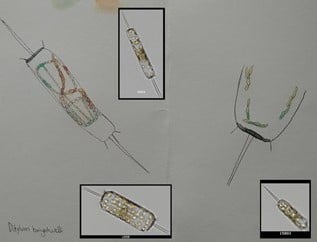 |
(Left) An OS101 student shows off his sketch of a Pseudo-nitzchia sp. cell based on FlowCam images. (Right) A close-up of another student’s sketches of Ditylum brightwelli, a common diatom found in the Gulf of Maine.
By this point in the course, students had already had 5 weeks of instruction in OS101 and experienced at least one research cruise to learn about plankton collection and preservation techniques. Introducing the FlowCam at this stage in the course allowed students to make connections to previous lessons on topics like primary productivity and the carbon cycle. Meanwhile, Whittaker and Whitney utilized YFT’s online FlowCam training tools and 1:1 virtual training sessions to learn how to use the FlowCam and prepared to integrate it into their course curriculum.
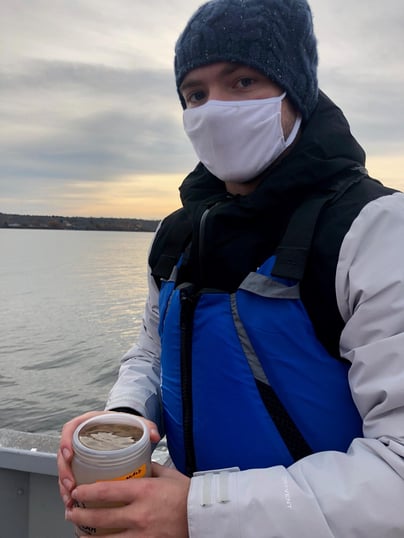 |
|
Throughout the semester, students participated in several half-day research cruises aboard MMA’s research vessel, the R/V Friendship. Here, a student holds the cod end of a plankton net containing a concentrated plankton sample collected in Penobscot Bay. |
Many students were “awestruck by the phytoplankton diversity,” said Whittaker. In an entry level course like OS101, this was most students’ first time seeing plankton up close. With more time, Whittaker and Whitney both said they would have liked to have had students be able to do phytoplankton identification and enumeration on their samples using regular microscopes, too, to fully appreciate the high throughput capabilities of the FlowCam. “Regardless, the students gained valuable exposure to cutting-edge, high-throughput technology that I hope will serve them well in their future research endeavors,” Whitney reflected.
In the second FlowCam lesson, students saw how VisualSpreadsheet can be used to identify and enumerate key taxa and to obtain size distributions using libraries and filters, respectively. Students used Excel to display and discuss the data collected on their research cruises in the Bay.
This lesson included a discussion of how students interpreted their data. Whittaker said it helped students understand “the need for replication and importance of data quality.” Students also noticed key features about each of their stations, which stretched from up the Penobscot River out into the Bay.
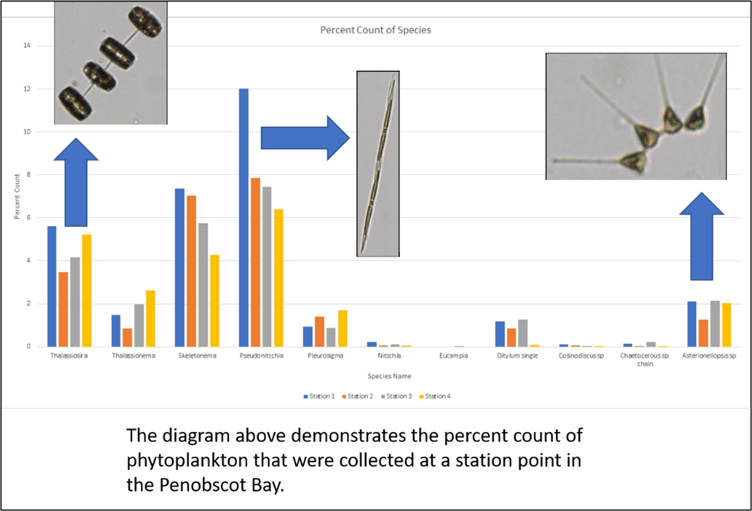
An example of a graph created by an OS101 student indicating the percent count of key phytoplankton genera across the 4 stations. In their analysis, this student noted the overall diversity found in their samples and observed that percent counts ranged from a “0.05 percent count in Coscinodiscus sp., all the way to 12 percent count in Pseudonitzchia sp.” The student also noted that percent counts were generally higher at Station 1.
During their cruises in Penobscot Bay, students were confronted with situations that forced them to troubleshoot equipment in the field: a key skill for any aspiring oceanographer. One day aboard the R/V Friendship, for example, students came to find that their CTD rosette—a metal frame outfitted with bottles for sampling and a sensor to measure conductivity (a proxy for salinity), temperature, and depth—was not receiving commands or transmitting data, so they had to find another way to collect the same data using other tools available onboard including a handheld CTD and Niskin bottle.
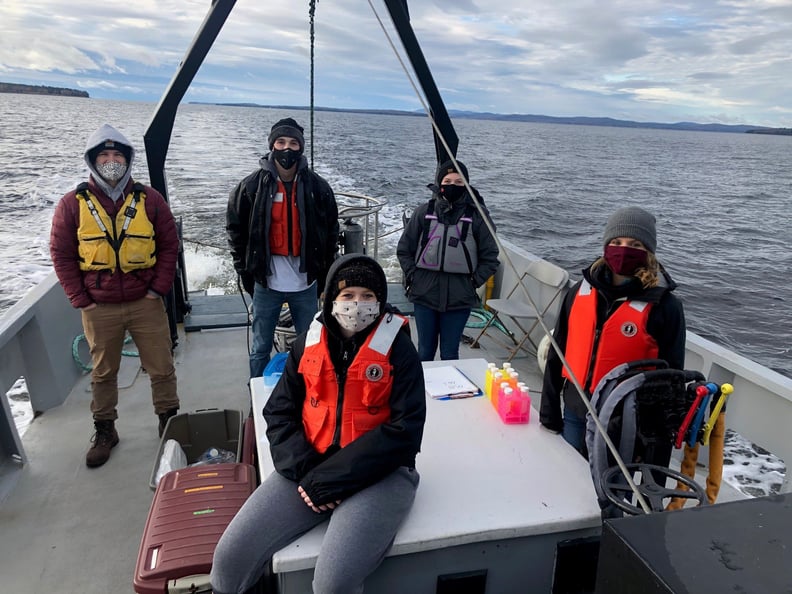
During their time at sea, students learned and practiced how to deploy oceanographic equipment like a CTD, Secchi disk, and plankton nets at 4 different stations in Penobscot Bay, and learned how to troubleshoot equipment as needed. At each research station students collected plankton samples that they preserved in Lugol’s for FlowCam analysis. In a “normal” semester, Whittaker and Whitney would have liked to take the FlowCam 5000 onboard the vessel to run live samples in real time but were not able to due to Covid-19 restrictions on the number of people that could stand in the wheelhouse. Instead, they brought samples back to shore for FlowCam processing.
As their students were learning how to troubleshoot equipment in the field, Whittaker and Whitney sometimes had to demonstrate problem solving in the classroom. As any educator knows, successfully learning a new tool and executing a new lesson for the first time requires preparation plus a certain degree of trial and error.
“Having only had a short period of time to acquaint ourselves with the FlowCam meant we had to troubleshoot on the fly with the students; while sweat-inducing, the students were able to see us persevere and problem-solve any technical issues that arose all for the love of phytoplankton! Any issues we had were greatly mitigated due to the wonderful resources YFT provided including the online training tools and virtual technical support from their team members.”
While learning how to run the FlowCam in front of a class required preparation and practice, Whittaker reflected that overall, “The FlowCam 5000 was easily incorporated into our course, allowing us to use high-throughput image analysis to characterize natural marine phytoplankton populations and involve students in the process of authentic data collection and analysis.”
Throughout the semester, Whittaker and Whitney also had to adapt their teaching to comply with Covid-19 restrictions. For example, class sizes were reduced, and the number of lab sections was increased, meaning that Whittaker and Whitney had to divide and conquer when it came to instruction, especially for research cruises. It also meant that Whittaker and Whitney ran samples on the FlowCam outside of class and shared data with students electronically.
Considering these challenges, Whitney noted that they felt fortunate to receive the FlowCam during this unusual time in history. “Covid-related issues meant that our lab times were shorter and posed challenges with regards to students using shared resources, like microscopes,” Whitney said. “Having access to the FlowCam allowed us to process samples quickly while visually capturing and sharing the tremendous diversity of the phytoplankton community of Castine Harbor with the students.”
“Through our use of the FlowCam 5000 this semester, we have inspired future marine scientists and phytoplankton aficionados; many of these students will go on to fields of oceanography, environmental science, and engineering.”
We extend our gratitude to MMA’s Corning School for Ocean Studies for pioneering this inaugural equipment grant for undergraduates. Thanks to their success, we plan to offer the undergraduate grant program again in 2021. An announcement will be made in January with details on how to apply. Subscribe to our blog to receive the latest updates.
Whittaker and Whitney have also generously agreed to share their lesson plans with other educators upon request. Email Savannah at savannah.judge@fluidimaging.com to receive a copy and discuss ideas for how lessons can be adapted for different academic levels or subject areas.







